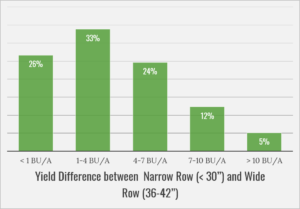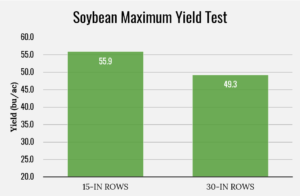Next up in our Management Decisions series we talk row spacing. But first, if you missed our articles on weed management, seeding rates, or planting date catch up by clicking the links.
Row spacing is something we get a lot of questions about and the truth of the matter is a wide range of row spacings have been successful for North Carolina soybean growers. Often, row spacing decisions are made based on what equipment is already available, which is perfectly fine. There are many growers in the Coastal Plain that see impressive yields by planting on 36-inch rows.
But in the tests we have conducted over the last 20 years, we typically saw a yield advantage for soybeans in rows 20 inches or less. Which makes sense because narrower row spacing allows for quicker canopy closure, greater light interception, helps block light from reaching weeds, and helps minimize moisture loss.
In a series of on-farm tests in North Carolina, soybeans in 10- and 20-inch rows yielded 3 bu/A higher when planted early, and 4 bu/A higher when planted late, than soybeans in 36- to 40-inch rows. There was little difference in yield between the 10-inch and the 20-inch rows. The 26% of the time when there was virtually no difference (< 1 bu/A) in yield between wide (greater than 30 in) and narrow (less than 30 in) rows was mostly in droughty environments. Water was the limiting factor for both narrow and wide rows here, not row width. The 1 in 20 times that the narrow row advantage was more than 10 bu/A occurred mostly in high yield environments (60 bu/A or more).
Also of interest in this series of on-farm tests is how the soybeans in wide rows never yielded higher than soybeans in narrower rows. That’s not to say that soybeans in wide rows couldn’t yield higher than soybeans in narrow rows (we’ve heard anecdotes of this happening), but they didn’t in the first 1,026 times it was tried in our controlled tests.
More recently, in the Maximum Yield test the North Carolina Soybean Producers fund with Dr. Dunphy, results have shown that soybeans in 15-inch rows yielded 6 bushels/acre higher than soybeans in 30-inch rows. Interestingly, both sets of tests showed a greater advantage for narrow rows in higher yielding environments than in lower yielding situations. This implies that as farmers raise their yield levels, narrow rows will become more important. So if you are looking to push your yields, you may benefit from narrower rows.
Also, row spacing alterations are more likely to be beneficial if canopy closure does not occur prior to bloom. Therefore, the benefits of narrow row spacing increase as the planting date becomes later. For double-crop fields, narrowing that row spacing will help the plants intercept more light and close their canopy quicker, increasing yield while also minimizing weeds and moisture loss.









